LoRa vs LR-FHSS
Advantages of The New LoRaWAN® Physical Layer
This article will present some numerical data and also some real scenario measurements in order to compare the new LoRa Frequency Hopping Spread Spectrum modulation scheme used post LoRaWAN 1.0.2 spec.
1. Introduction to LoRa®
Over the past 5 years LoRaWAN® has quickly become one of the dominant players in the IoT networks space. It enables long range, energy efficient communication between sensors and actuators distributed both indoors and outdoors. It is a cost-efficient technology backed by an easy to deploy and maintain network architecture. At the physical layer core of the LoRaWAN stack sits LoRa®, which is a type of Chirps Spread Spectrum (CSS) modulation acquired and trademarked by Semtech.
LoRa has been designed for extremely long-range communication (10km+), thus it prioritizes stability over data rate. It allows one to find the right balance between bandwidth utilization and robustness via its many combinations of Spreading Factors (SF), frequency channels and channel bandwidths.
LoRaWAN using LoRa relies on the ALOHA -based communication technique that is limited by regional duty-cycle regulations (and/or Listen Before Talk (LBT) mechanics). This reduces complexity, however sacrifices scalability and maximum achievable throughput.
LoRaWAN and LoRa have seen huge adoptions worldwide, it would not be an exaggeration to say that it is perhaps the most widespread IoT technology nowadays. Despite this fact it has a number of inherent shortcomings, particularly in very densely deployed networks, the overall capacity is severely limited due to its simple Media Access Control (MAC) protocols.
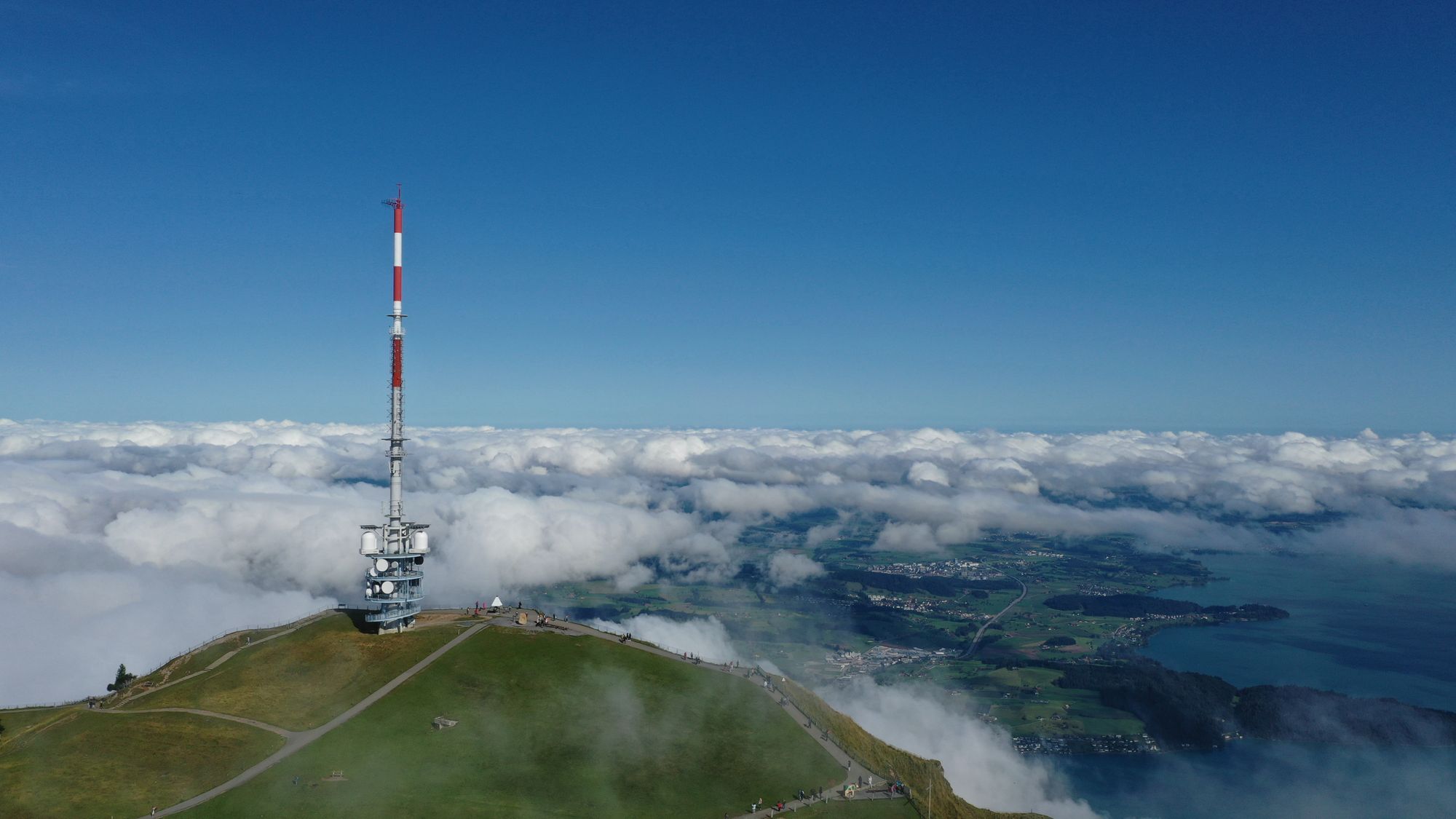
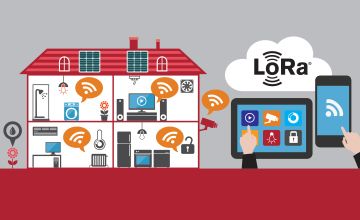
2. LR-FHSS Overview
Thus, to tackle long-term scalability issues, Semtech has announced an extension of the LoRa physical layer called LR-FHSS. It is to mitigate problems created by the inevitable emergence of large-scale, dense LoRaWAN deployments by increasing network capacity and robustness via the use of Frequency Hopping (FH) techniques. It enables intra-packet frequency-hopping to achieve better capacity, sensitivity, and interference rejection than traditional modulation schemes that use a single channel. At the same time, this improvement does not come at the cost of reduced communication range or power efficiency, which are the two main characteristics of these types of Low Power Wide Area Networks (LPWAN). Last, but not least it is designed to improve LoRa Satellite communication in order to promote its more widespread adoption.
LR-FHSS is solely designed to be used for Uplink, downlink in class A still uses LoRa and the same RX1/RX2 windows.
LR – FHSS encodes a low data rate bit stream onto a comparatively wide bandwidth by switching frequency rapidly during the transmission of a single radio packet. The bandwidth used by the frequency-hopping algorithm can be set between 39.06 kHz and 1.5742 MHz. The 6 dB modulation bandwidth is 500 Hz. The LR-FHSS instantaneous modulation baud rate is 488.28125 baud, using 2-GMSK modulation and BT=1 (Chirp Spread Spectrum modulation is not used anymore).
With hopping enabled, each LR-FHSS packet is spread over multiple frequency grids.
The packet header contains information used by the gateway to compute the frequencies that the packet will use. Multiple headers are transmitted to ensure reception robustness.
Table 1 below compares the narrowest bandwidth channel to the widest one, so one can gain perspective on how wide a range of hopping grids and channels one can have.
| LR-FHSS Frequency Hopping BW (all hops) |
LR-FHSS BW of a single hop |
Minimum separation between LR-FHSS hopping channels (grid) |
Nb of physical channels usable for frequency hopping per end-device transmission |
Nb of physical channels available for frequency hopping |
Coding Rate |
Physical bit rate |
| 39.06 kHz |
488 Hz |
3.9 kHz |
35 |
80 |
1/3 |
162bits/s |
| 1.574 MHz |
488 Hz |
25.39 kHz |
60 |
3224 |
1/3 |
162bits/s |
As an example of how a packet would be transmitted consider the figure below. The packet is split over several frequency grids, covering the allotted bandwidth for the channel. In particular, we have the packet header replicated 3 times (HRD 1, HDR2, HDR3) in addition to the original one (HDR0). This is an option, but recommended for robustness.
Next, the data payload is split over multiple frequency grids (PL1 to PLN) till the whole of it is transmitted (the number of grids used would depend on the packet size, where the header is pre-defined).

3. Key benefits
- LR-FHSS uses intra packet hopping, which allows it to utilize lower data rate (longer range) to carry longer payloads, but comply with dwell time regulations
- If it is used in spectrum constraint regions (EU868 for example) it can provide significantly better network capacity and per device range compared to LoRa
- It provides more interference robustness (due to FHSS), it scales especially favorably as network size grows (LoRa is the opposite)
- LR-FHSS devices are 1W compliant in the US
- LR-FHSS supports larger frequency drifts (no need for TCXO)
- Very robust to Doppler shifts, thus suitable to for Satellite communications
4. Physical Layer Performance
The section gives a summary of physical layer performance and any potential improvements to be made.
4.1 Link Budget
In ETSI regions LR-FHSS has a similar link budget (range) as the lowest LR-CSS data rate (SF12BW125kHz)
However, in the FCC region on the 915MHz band, LR-FHSS greatly outperforms LR-CSS. This is due to the fact that it can be certified for up to 30dBm output power, 8dB more than is permissible to LR-CCS for an 8/16 channel gateway. The gateway itself is 2dB more sensitive than LoRa (SF10BW125).
| Parameter |
LoRa (8/16 channel gateway) |
LR-FHSS |
Difference to LoRa |
| Max TX Power |
22dBm |
30dBm |
8dB |
| Best Sensitivity |
-135dBm |
-137dBm |
2dB |
| Link Budget |
157dB |
167dB |
10dB |
In summary, the 10dB link budget improvement results in 3X free-space and 1.5X terrestrial range improvement.
4.2 Robustness and Interference Rejection
Semtech conducted a series of tests using an SX1301-based V2 gateway and an SX1262 node, the results are presented as follows.
Co-Channel Blocking
The figure below compares and outlines the performance improvements of LR-FHSS if the presence of a CW (continuous wave) blocker in the chosen transmission channel.
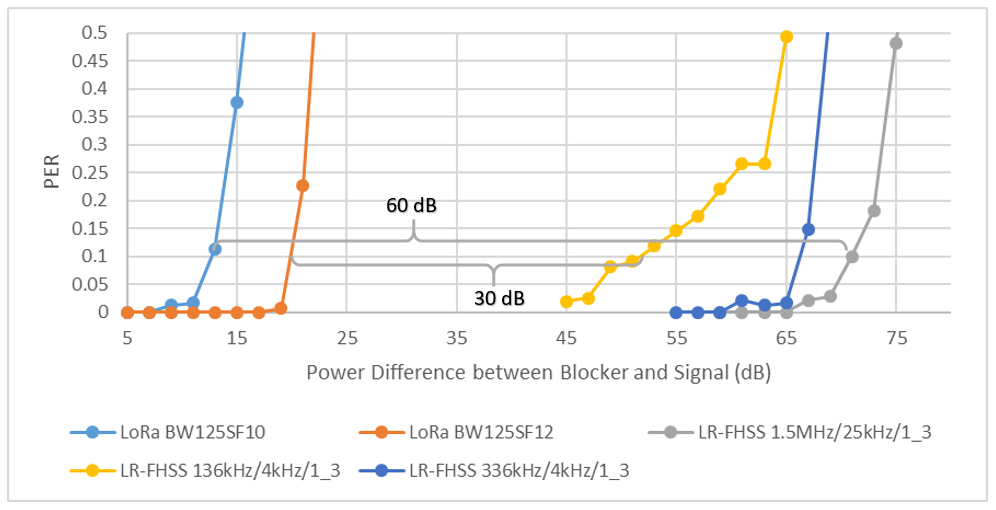
In summary:
LR-FHSS is about 60dB better in FCC regions (1.5MHz LR-FHSS vs SF10BW125 LoRa)
Better than 30dB in ETSI
Rejection increases with channel bandwidth
Adjacent-Channel Rejection
In case the blocker and signal are more than 1MHz apart, most modulation techniques perform similarly, with the exception of LoRa SF10BW125, which performs significantly worse.
In most cases better than 90dB blocking is achieved (given an offset >2MHz)
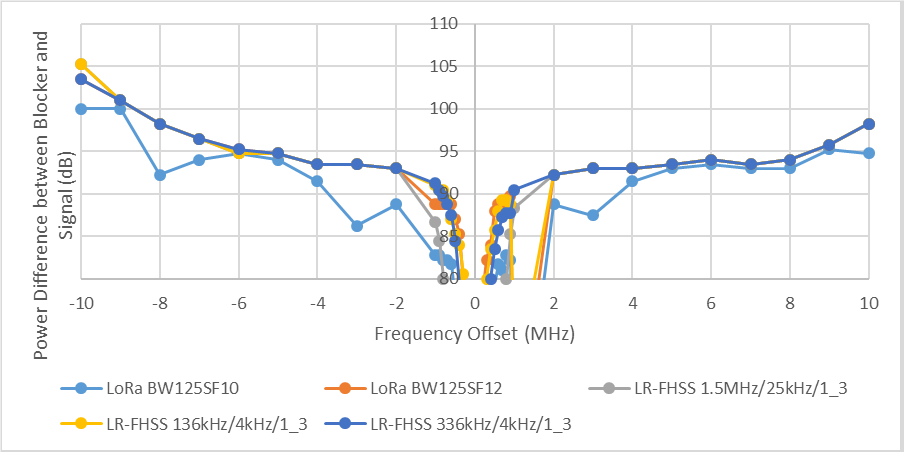
In smaller offsets (<1MHz) performance degrades as expected (most are around 70dB), however as the offset reaches +/- 60kHz, LoRa dramatically suffers in performance, dropping down to about 20dB.
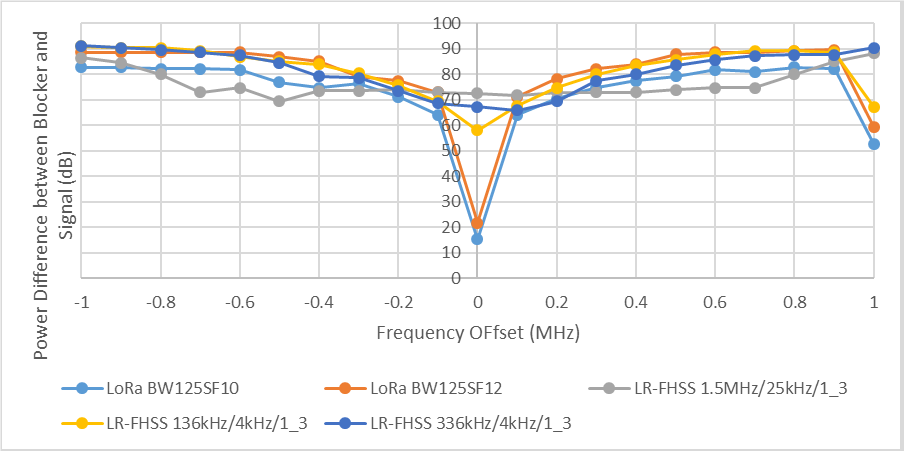
In summary:
Due to intra-packet hopping LR-FHSS provides additional co-channel blocking.
If the blocker is not in the wireless channel, LR-FHH significantly outperforms LoRa in cases where the offset is greater than 1MHz.
4.3 Burst Blocker Rejection
As LR-FHSS spreads the packet over multiple frequency grids over a large bandwidth it is harder for a blocker to jam the whole packet. Coupled with the coding overhead, it makes for a modulation very robust to burst blocking, as is true for all frequency hopping systems.
In the graphs below the duty cycle tolerance is evaluated. The blocker has an 83dB higher power than the signal and a period of 2s (varying ToA).
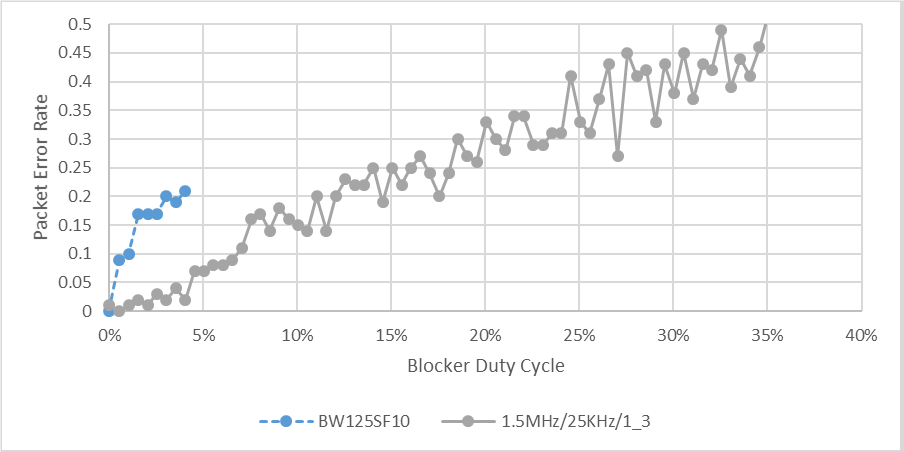
In the FCC case, LR-FHSS provides significantly better performance. For example, at 4% duty cycle LR-FHSS has PER of 3%, whereas LoRa drops to 20%.
4.4. Field Measurements
Semtech conducted a field measurement campaign to evaluate range and signal quality.
The test gateway (receiver) was positioned on the roof of the Semtech Neuchâtel office.
The transmitter power was fixed at 14dBm.
Measurements were taken at 868MHz using a combination of FCC and ETSI parameters.

We use the Packet Error Rate (PER) as a performance metric of wireless transmission range and interference rejection in the case of our urban environment test.
- In FCC regions LR-FHSS starts to outperform LoRa (SF10, 3X) when CR 1/3 is used and the improvement scales with range, so the further you are the greater the advantage of LR-FHSS. SF10 3X is taken as it has similar time on air (ToA), SF10 being too short for comparison.
- Int ETSI regions clearly outperforms even LoRa SF10

5. Network Performance
Let us assume we have a single-hop network with one or more gateways and multiple nodes and look into capacity and latency performance.
5.1. Capacity
Using a mathematical model to simulate performance, in case a single gateway is considered, the following has been found by Semtech.
Single channel LoRa network, using ALOHA channel access (PER target of 10%) can achieve a capacity of:
- 150k packets per day (ADR turned on, mostly SF7 traffic)
- 5k packets (SF12 is used instead, no ADR).
For the same PER of 10%, LR-FHSS achieves much greater capacity. The comparison can be seen in the following graphs (1st for a 125kHz channel, 2nd for a 1.5MHz one).
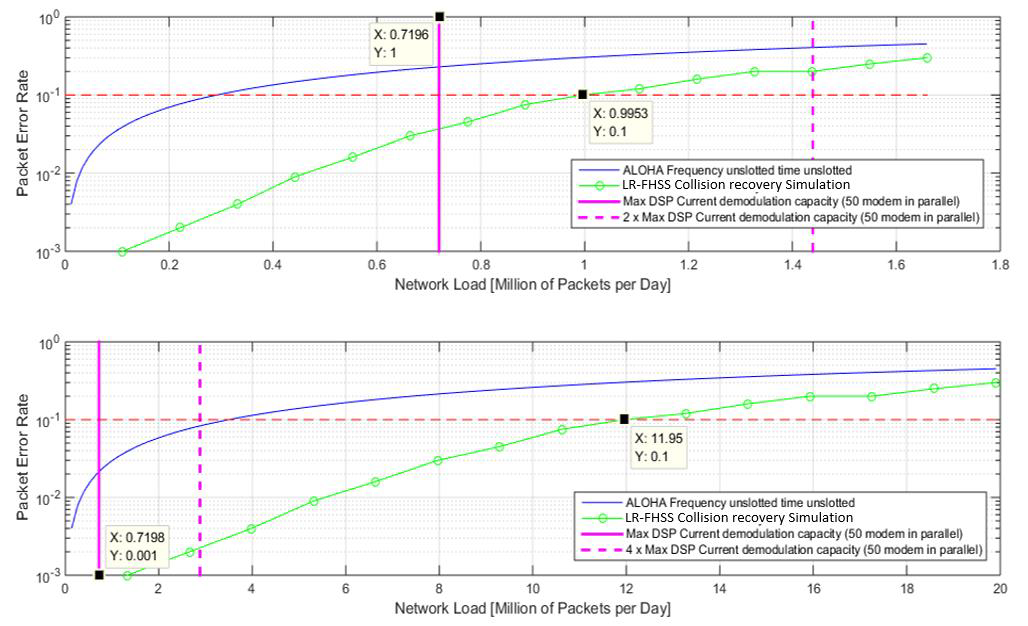
In both graphs, it can be observed that LR-FHSS’s PER grows linearly, rather exponentially like LoRa, resulting in the following improvement
- 1 mil packets per day (ETSI 125kHz bandwidth, PER 10%)
- 11 mil packets per day (FCC 1.5MHz bandwidth, PER 10%)
The numbers are summarized in the following table and are theoretical only, in practice the limit is 700k due to DSP processing limitations.
In summary, LR-FHSS achieves a 140x improvement (700k/5k) for devices that are far (low data rate SF12).
If a simulation on the uplink capacity per gateway is carried out some interesting results present themselves. If we have the following system parameters:
Band: EU868
Payload: 12x32 bytes per day
RF propagation model: Urban Hata with fading and 20-40dB indoor losses
we come up with the following graph:
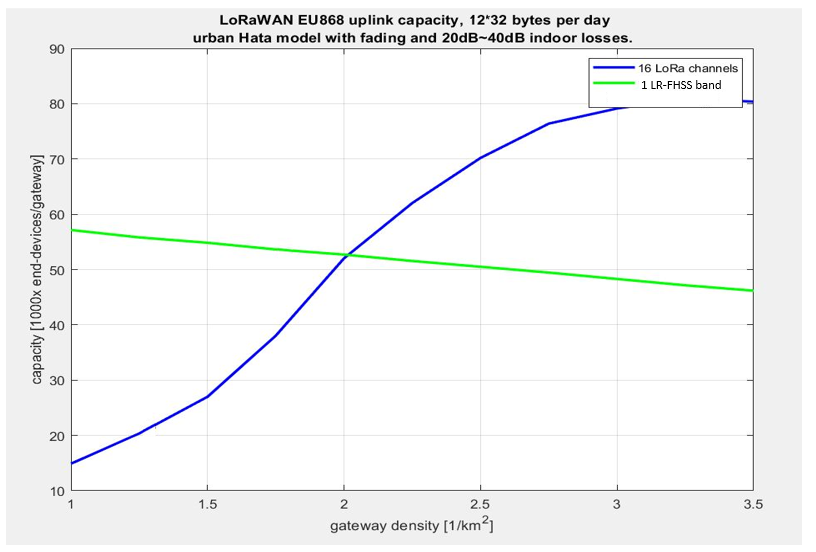
LR-CSS has a clear advantage, where the per gateway capacity increases as the size of the network grows and more gateways are added. LR-FHSS behave in the opposite way, where the actual capacity decreases.
This proves that LR-FHSS is more suitable for deployment scenarios with lower gateway densities, like satellite or rural deployments (as capacity per gateway is still high). LoRa still has the advantage in dense urban.
6. Implementation Considerations
The following is a set of parameters and/or requirements to take into consideration if one plans to deploy an LR-FHSS system.
Gateway
A Semtech reference design LoRa® Gateway V2 is required for LR-FHSS to be realized, provided an external DSP is used. Both 16 and 64-channel designs are available.
The current reference design uses SX1308 FPGA and OMAP-L138 DSP. SX1301 gateways are supported after the firmware is updated.
End-Node
Assuming a typical sensor device using SX1262 without external PA, 6 reports per day with 20 bytes physical payload, the annual power consumption is shown in the table below:

8. Summary
The following are the key points that make LoRa-FHSS the successor to inherit the crown of LoRa as the most widespread IoT Wireless Network Access mechanic.
It provides a significant increase in the scalability of the network. Given that this issue is going to be more and more prominent as IoT is getting adopted at an unprecedented scale worldwide, it is a must-have for a technology such as LoRaWAN. This, however, comes at the cost of individual device capacity, which indicates that perhaps LoRa will still be used in certain use case scenarios in the future and will not be completely replaced.
Additionally, as the scalability benefits only come when the network becomes very large (larger than existing LoRaWAN networks), one might consider it less suited for small-scale deployment in the case of segregated network deployments, where LoRa would still be better suited. Naturally, LoRa P2P would still remain dominant.
Last but not least it is a work still in progress and there are still issues to be tackled, for example, the optimization of the hopping sequence algorithm, as it directly affects goodput and collision probability.
In the end, there is strong evidence that LoRa-FHSS offers significant benefits over LoRa, and its efficiency scales with the size of the network, while offering the same long-range and battery life.
It is more likely than not that it will become the physical layer of future LoRaWAN networks.
What would this mean in practice for LoRaWAN developers in the future:
- Interference mitigation will be less of a factor in design
- As networks will scale to a much larger number issues will star to appear at the backend too and handling the aggregated traffic at the server end, the current scheme would probably need to be redesigned.
- Because of the frequency hopping mechanics, the end-nodes will be more complex and their power saving algorithms would have to be adjusted accordingly.
- A ton of new use cases will appear that have not been investigated yet, for example mesh networks using LoRa-FHSS.
- New investigations would have to be carried out in order to make comparison to contending technologies like Satellite Nb-IoT for example.
2. References:
1. Opportunities & Capabilities Created by the Inclusion of the LR-FHSS Modulation in LoRaWAN, Technical Webinar, 12 April
3. https://lora-alliance.org/resource_hub/rp2-1-0-3-lorawan-regional-parameters/









